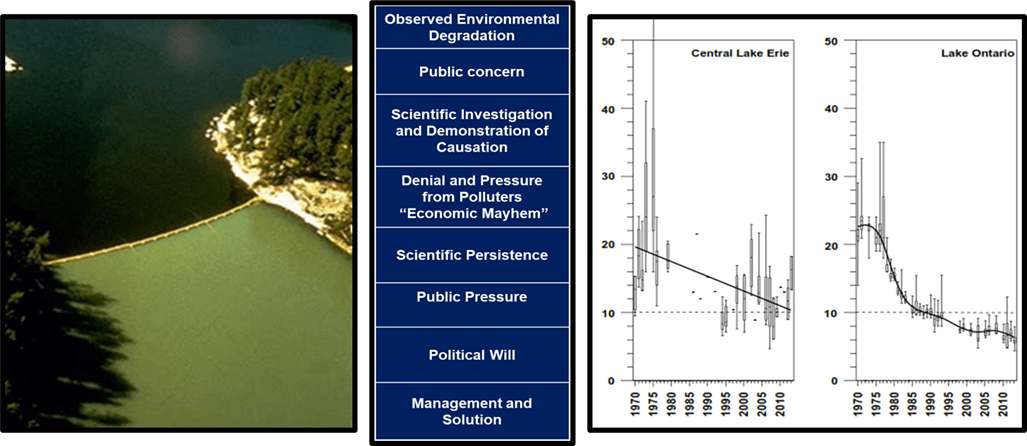A History of Environmental Actions.
‘Polluters deny, obfuscate and predict’ harm to the economy with scientists’ persistence eventually leading to change.
by Neil Hutchinson.

As a teenager in high school I learned that Lake Erie was dying.
Prolific growth of algae was turning the water green, choking the beaches and robbing the lake of oxygen as it decomposed. Scientists concluded that excess phosphorus was the culprit. Phosphorus is what we call a “limiting nutrient” for freshwater because, while nutrients like carbon and nitrogen are required for algal growth, phosphorus was in shortest supply and so controlled algal growth. Phosphorus entered the lake mostly through sewage effluent rich in phosphate from detergents. Worldwide, many lakes suffered — we called the problem “cultural eutrophication.”
Yet, those who produced phosphorus argued that phosphorus was not the problem, that eutrophication was natural, that carbon and nitrogen were the culprits, or that the cost of management would cripple the economy. There was some public awareness within the emerging environmental movement but pressure to solve the problem was weak. Politicians and decision makers did not act.
But scientists persevered and, in a world-famous experiment, Canadian scientists divided a small lake near Kenora Ontario into two halves using a large plastic curtain. They added carbon and nitrogen to one half and carbon, nitrogen and phosphorus to the other. The side with the added phosphorus “bloomed” bright green while the other side showed no response to the added nutrients.
The photograph showing this (above, left) was on the cover of the world’s top scientific journal when the study was published; the image was so striking it became viral breaking news, alerting society as a whole.
Resulting public pressure created political will and action — banning the use of phosphorus in detergents and upgrading wastewater treatment plants to remove 90% of the phosphorus from their discharges to the Great Lakes. Phosphorus levels in Lake Erie and Ontario dropped and Lake Erie recovered quickly. And guess what? The economy continued to thrive!
I saw the same pattern in the 1980s when acid rain and ozone depletion were recognized as hazardous by the scientific community and were linked to human discharges of sulphur dioxide and chlorinated compounds into the atmosphere. The responsible industries denied their link to the problem and cried “economic mayhem” at the threat of controls. Politicians listened — for a while. But more research confirmed the problem.
The public listened, applied political pressure and, in Canada, the Mulroney government took action: first leading negotiations leading to the 1991 worldwide phase-out of the chlorinated compounds that were damaging the ozone layer and, second, negotiating an Acid Rain Accord with the U.S. in 1991 to reduce sulphur dioxide emissions by 90%. And guess what? The economy continued to thrive!
I have seen this pattern repeat throughout my career: Observed environmental degradation leads to public concern, scientists identify the source and demonstrate the cause but the polluters deny, obfuscate and predict “economic mayhem” if we tackle the problem. Initially, no political action is taken.
Scientists persist, the general public becomes concerned, and political pressure stimulates a solution.
But this pattern has yet to complete for the most serious problem of all — human induced climate warming. I learned of it as the “greenhouse effect” in my ecology textbook in 1974. It rose to concern at the Rio summit of 1992, the Kyoto summit of 1997 and six increasingly alarming assessment reports from the Intergovernmental Panel on Climate Change between 1990 and 2023.
Yet we have not acted. The fossil fuel industry continues to deny and obfuscate. People are complacent or in denial. And many politicians continue to ignore the threat while opposing emissions reduction and campaigning to “axe the carbon tax” — an action that economists show will do nothing to help the economy and which will accelerate global warming.
The threat of climate change is real and we have solved past environmental problems without the “economic mayhem” claimed by the polluters. The recent history of environmental success stories tells me it’s time to take the next steps to manage our warming of the planet.

This is article #5 in the current series of articles from Muskoka Watershed Council, published on MuskokaRegion.com on December 21, 2024. Its author is Dr. Neil Hutchinson, a retired aquatic environmental scientist, Bracebridge resident and Director with the Muskoka Watershed Council, Friends of the Muskoka Watershed, and Georgian Bay Forever.
